Best Full-Size Framing Nailer – Head-To-Head
Full-Size Pneumatic Framing Nailers
Head-to-Head Testing
Pneumatic nailers first started gaining ground in the construction world in the 1950’s. While the underlying technology hasn’t changed much; features, size, weight, and function have all been improved drastically. Even though pneumatic nailers can’t replace hammers on the job-site, they have become just as common.
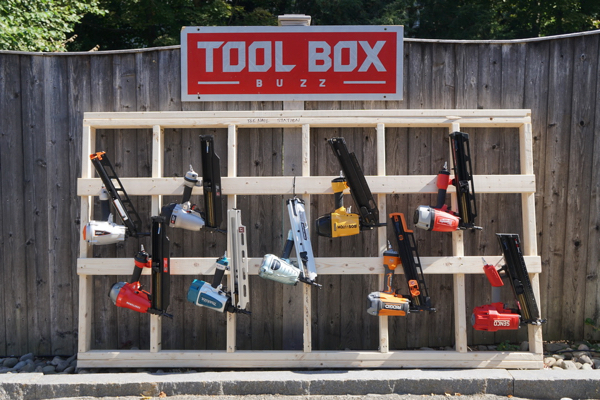
Newer building materials like engineered lumber put today’s nailers to the test. Users can become frustrated when they have to follow up a pneumatic nailer by hand-banging “proud” nails into LVL headers. Whether you’re looking to avoid this frustration and want a nailer that is powerful enough to penetrate engineered lumber, or your new to the game, and need a “do-it-all” framing nailer this Head-to-Head will guide you on the proper choice. This test will give you the information you need to choose the best full-size framing nailer.
Full Head, Full-Size Framing Nailer Specifications and Features
For this Head-to-Head evaluation, nailers were chosen based on the following criteria: Capable of firing up to 3-1/2″ full-head framing nails, full-size tools (nothing from the compact category), and capacity to hold at least two full strips of nails.
The challenge for any Head-to-Head is developing the testing and evaluation criteria to create a valuable comparison for Pro users. There are many different tests that could be performed. However, with limited time and resources, this evaluation focuses on real world tasks found on many of the jobs we work on. These tasks have measurable and realistic applications to give you a good baseline on performance and expectations.
We included the following framing nailers in the Head-To-Head test:
Bostitch F21PL 21º Full Round Head 3-1/2” Framing Nailer
- Collation Type: Plastic
- Depth Adjustment: Yes
- Dry Fire Lockout: No
- Fastener Length: 2″ to 3-1/2″
- Fastener Type / Gauge: 21º
- Firing / Actuation Mode: Sequential with Additional Trigger Included
- Magazine Capacity: 60
- Magazine Loading: Bottom load
- Operating Pressure: 80-120 psi
- Power Source: Pneumatic
- Height: 14”
- Length: 20-3/8”
- Width: 5-1/4”
- Weight 8.1 lbs.
- Bostitch F21PL
Craftsman CMP21PL 21º 3-1/2” Framing Nailer
- Collation Type: Plastic
- Depth Adjustment: Yes
- Dry Fire Lockout: Yes
- Fastener Length: 2″ to 3-1/2″
- Fastener Type / Gauge: 20-22º
- Firing / Actuation Mode: Tool-free selectable trigger
- Magazine Capacity: 60
- Magazine Loading: Bottom load
- Operating Pressure: 70-120 psi
- Power Source: Pneumatic
- Height: 14.76 in
- Length: 21.65 in
- Width: 4.72
- Weight 8.2 lbs.
- Craftsman CMP21PL
Makita AN924 21º 3‑1/2″ Framing Nailer
- Collation Type: Plastic
- Depth Adjustment: Yes
- Dry Fire Lockout: Yes
- Fastener Length: 2″ to 3-1/2″
- Fastener Type / Gauge: 21º
- Firing / Actuation Mode: Switch – tool free
- Magazine Capacity: 73
- Magazine Loading: Top load
- Operating Pressure: 70-120 psi
- Power Source: Pneumatic
- Height: 13-3/4”
- Length: 22”
- Width: 4-5/8”
- Weight 8.3 lbs.
- Makita AN924
Metabo HPT NR90AD(S1) 21º 3-1/2″ Paper Collated Framing Nailer
- Collation Type: Paper
- Depth Adjustment: Yes
- Dry Fire Lockout: No
- Fastener Length: 2″ to 3-1/2″
- Fastener Type / Gauge: 30º
- Firing / Actuation Mode: Tool-free selectable trigger
- Magazine Capacity: 86-94
- Magazine Loading: Rear
- Operating Pressure: 70-120 psi
- Power Source: Pneumatic
- Height: 13-3/4
- Length: 18-3/16”
- Width: 4-15/16”
- Weight 7.0 lbs
- Metabo HPT NR90AD(S1)
Milwaukee 7200-20 21º 3-1/2″ Framing Nailer
- Collation Type: Plastic
- Depth Adjustment: Yes
- Dry Fire Lockout: Yes
- Fastener Length: 2″ to 3-1/2″
- Fastener Type / Gauge: 20-22º
- Firing / Actuation Mode: Tool-free selectable trigger
- Magazine Capacity: 64-72
- Magazine Loading: Rear
- Operating Pressure: 70-120 psi
- Power Source: Pneumatic
- Height: 14-1/4”
- Length: 21-3/8”
- Width: 4-3/4”
- Weight 7lbs. 12 oz
- Milwaukee 7200-20
Paslode PowerMaster Plus 30º F350-S 3-1/2” Framing Nailer
- Collation Type: Paper
- Depth Adjustment: Yes
- Dry Fire Lockout: No
- Fastener Length: 2″ to 3-1/2″
- Fastener Type / Gauge: 30º
- Firing / Actuation Mode: Yes
- Jam Clearance: Yes
- Magazine Capacity: 84
- Magazine Loading: Rear
- Operating Pressure: 80-120 psi
- Power Source: Pneumatic
- Height: 13-1/2
- Length: 19.3/8”
- Width: 5-1/8
- Weight 8.4 lbs.
- Paslode PowerMaster Plus
Porter-Cable FR350B 22° Framing Nailer
- Collation Type: Plastic
- Depth Adjustment: Yes
- Dry Fire Lockout: Yes
- Fastener Length: 2″ to 3-1/2″
- Fastener Type / Gauge: 22º
- Firing / Actuation Mode: Tool-free switch
- Jam Clearance: Yes
- Magazine Capacity: 60
- Magazine Loading: Bottom load
- Operating Pressure: 70-120 psi
- Power Source: Pneumatic
- Height: 14.76
- Length: 21.65
- Width: 4.72
- Weight 8.25 lbs.
- Porter-Cable FR350B
RIDGID R350RHF 21° 3-1/2 in. Framing Nailer
- Collation Type: Plastic
- Depth Adjustment: Yes
- Dry Fire Lockout: Yes
- Fastener Length: 2″ to 3-1/2″
- Fastener Type / Gauge: 20-22º
- Firing Actuation Mode: Tool-free switch
- Jam Clearance: Yes
- Magazine Capacity: 60-70
- Magazine Loading: Bottom load
- Operating Pressure: 80-120 psi
- Power Source: Pneumatic
- Height: 15.25”
- Length: 22.44”
- Width: 4-3/4”
- Weight 7.3 lbs
- Ridgid R350RHF
Senco FramePro 752XP 3 1/2″ Framing Nailer
- Collation Type: Plastic
- Depth Adjustment: Yes
- Dry Fire Lockout: Yes
- Fastener Length: 2″ to 3-1/2″
- Fastener Type /Gauge: 20º
- Firing/Actuation Mode: Sequential with Additional Trigger Included
- Jam Clearance: Yes
- Magazine Capacity: 60
- Magazine Loading: Bottom load
- Operating Pressure: 70-120 psi
- Power Source: Pneumatic
- Height: 14.1/4
- Length: 20”
- Width: 4-3/16
- Weight 8.7 lbs.
- Senco FramePro 752XP
Best Features
WINNER – Milwaukee
There were a few stand-out features that affect performance and safety. Each tool was ranked, using a 1 thru 5 score, 1 being the best, to determine the tool with the best feature ranking. A list of some of them are included below.
The Milwaukee took first place with Makita close on their heels. The team felt that the two nailers were almost equal with the Milwaukee having a slightly better contact tip. Third place was the RIDGID and Senco.
| Contact Tip | Depth Adjustmt. | Fire Mode | Rafter Hook | Dry Fire Lock Out | Totals | |
|---|---|---|---|---|---|---|
| Milwaukee | 2 | 1 | 1 | 2 | 1 | 7 |
| Makita | 3 | 1 | 1 | 2 | 1 | 8 |
| Ridgid | 2 | 1 | 3 | 4 | 1 | 11 |
| Senco | 1 | 2 | 5 | 2 | 1 | 11 |
| Metabo HT | 3 | 4 | 1 | 5 | 1 | 14 |
| Paslode | 3 | 5 | 5 | 1 | 1 | 15 |
| Bostitch | 2 | 3 | 5 | 3 | 5 | 18 |
| Craftsman | 5 | 4 | 4 | 4 | 1 | 18 |
| Porter-Cable | 5 | 4 | 4 | 4 | 1 | 18 |
Nail Loading
During this evaluation there was no consensus on a preference for top-loading vs. bottom loading nailers. For top-loading, the team chose the Paslode and felt that the two steel guide rails facilitated smoother nail loading and were more durable. For bottom loading, the team felt the Milwaukee was superior and its nail pusher release button was the easiest to use and most accessible.
In this head-to-head, 3-1/2″ full, round head nails were used. All but the Metabo HPT used plastic collated nails. The Metabo HPT tested, used paper tape Paslode RoundDrive nails. These nails are full-head, offset nails, as opposed to full-head concentric. The offset is due to the angle of the magazine, which is 30 degrees vs. 21-degree full-head concentric nail.
Contact Tip
Having a well-designed contact tip ensures the nailer does not slip and prevents nails from being installed incorrectly. The best contact tip in this test was the Senco. The Senco stood alone in this pack; it provided 360-degree coverage around the firing head and had more complex tangs to grip material without limiting access to tighter spaces.
Other nailers with great contact tips are the Milwaukee, RIDGID, and BOSTITCH. Rounded and aggressive, these contact tips quickly gripped all the materials tested and were consistent in their performance.
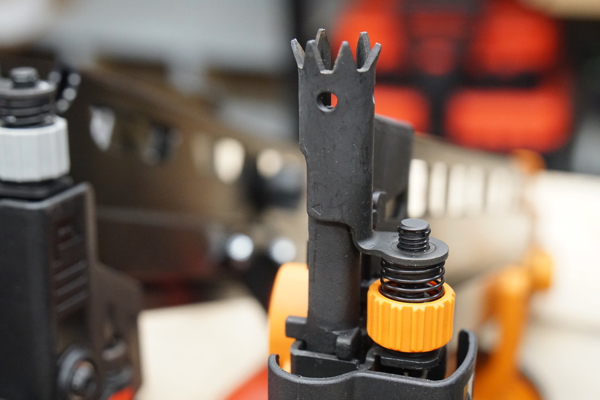
During the testing, we noticed that the Metabo HPT contact tip didn’t grab well at steeper angles when toe-nailing. The Craftsman and Porter-Cable, have identical tips, with tangs that are flat and not ground to a sharp point. We found them to slide on harder materials like the AdvanTech sheathing and LVL framing lumber.
The BOSTITCH is the only nailer that comes with a replacement tip that is a positive-placement nailer tip for metal connectors.
Depth Adjustment
The Makita, Milwaukee, and RIDGID stood out with the best placed, smoothest-to-operate depth of drive knob adjustment. On the Makita, we liked the visible scale that allows you to see the adjustment range. The Milwaukee and RIDGID both have a large adjustment wheel, but it’s hard to tell where in the depth adjustment you are compared to the other nailers. The Senco’s big knurled knob adjustment was the easiest to operate, and adjustment is smooth. It’s only negative is that it is directly in the line of sight.

An onboard Allen wrench is necessary for depth adjustments on the Paslode nailer. This method is an old-fashioned approach, and the Paslode nailer’s scoring suffered as a result.
Almost all of the nailers now have a tool-less adjustment dial. The BOSTITCH sports a unique tool-less “SLIDE” adjustment, which gives the user the benefit of speed, especially at extreme changes. We found the BOSTITCH adjustment easy, the tip completely slides in and out, but this could eventually be a concern due to the tip eventually falling out and get lost. The team felt that the nailers with a dial adjustment, a tried-and-true design, were more rugged and sensitive to minor tweaks, compared to the Bostitch slide model.
Clearing Jambs
Most jams are caused by a fastener, or part of a nail, jamming between the driver blade and the nail guide. Fastener strips with an incorrect collation angle or the wrong fastener type, (such as clipped head fasteners) may also cause continuous jamming.
To clear the jamb for all the nailers, except Senco:
- Disconnect the air supply
- Remove fasteners
- Insert a screwdriver or pin punch into the nail guide to push back the driver blade
- Once the driver blade is back in position, remove the nail or nail fragment with needle-nose pliers, if necessary
The Senco has a single-bolt, magazine removal procedure, for clearing stubborn nail jambs. An adjustable wrench or pair of pliers allows the user to loosen the bolt (not remove it), and the magazine slides out of the nose of the gun, allowing access to clear a jamb. This unique feature was simple and easy to do for jam clearing.
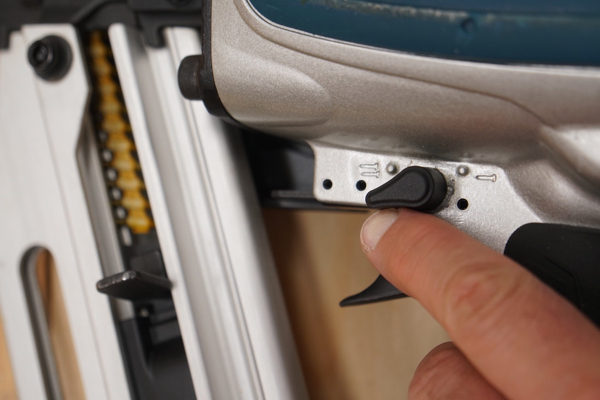
Sequential / Bump Fire Mode
All the nailers are capable of single fire mode, and sequential [bump] firing. For applications that have a consistent and repeating nailing pattern, like strapping or sheathing; bump-fire saves time and requires less effort on the part of the user.
Milwaukee had the best combination of “ease-of-use,” and safety and Makita followed in second place. Both nailers switch between firing modes by rotating switch. Milwaukee has a locking, rotating switch [push and twist], Makita has a simple switch with no lock or secondary actuation on the rotating mode switch.
The Craftsman, Porter-Cable and RIDGID have has a push-button, on one side of the trigger, that releases the selectable trigger knob and allows it to rotate. The only drawback is that it requires a two-handed operation.
The Craftsman and the Porter-Cable also have a trigger lock out.
Swapping Out The Trigger
The Bostitch, Paslode, and Senco tools require that the trigger be swapped out, to change firing modes, between sequential and bump fire. While this isn’t ideal for a “do-it-all,” framing gun, it’s typical for full-time framers who use task-specific guns and operate in mostly the bump firing mode.
Rafter Hook
Three nailers tested have metal rafter hooks: Paslode, Senco, and Makita. The team felt that Paslode has the BEST hook. Paslode’s spring-loaded hook has a 2-1/2″ opening. This hook is not reversible, has a 180-degree swing, and three detent positions [it locks in a stored position, at 90 degrees, and also swings against the magazine.]
The Senco 2-inch rafter hook is smaller profile and rounded, and seems more suited for a ladder rung – it almost seems like it was an afterthought. The Senco hook is a 180-degree swivel and is not reversible.
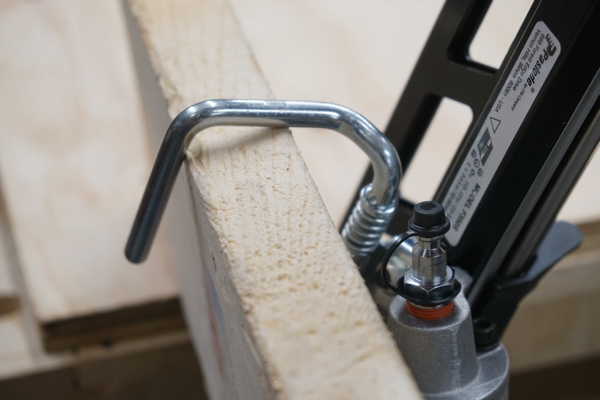
MAKITA has a fixed metal hook that is reversible by removing screws. It has two fixed-width options; 1-1/2″ or 2-1/2″ wide. The team found Makita’s hook sturdy, durable, and reliable.
I like this hook (Makita) it’s solid, and you know exactly what to expect! ~ ROB
While not fans of plastic hooks, the Milwaukee and Bostitch were the best. MILWAUKEE’s hook is beefy, with a 1-1/2 opening. This hook has some flex but swivels easily. Bostitch is a shorter hook, with locking indents, positioned high on gun, and is easy to use.
The Metabo HPT nailer, we tested, does not come with a rafter hook, a feature we feel is a MUST on a framing nailer (other Metabo HPT nailers do come with a hook). The RIDGID’s rafter hook is easy to swivel, but the team felt that the hook was too narrow, barely fits on 2x lumber. It also seems thinner and less durable.
Dry Fire Lockout
This feature prevents the nailer from firing when out of nails. Many manufacturers include this feature because it avoids unnecessary wear. It also eliminates the frustration of firing the nailer and discovering that the user has not set a nail. Bostitch is the only nailer without a dry fire lockout and was marked down for this. The team felt that lock-out is an important feature that Pros prefer.
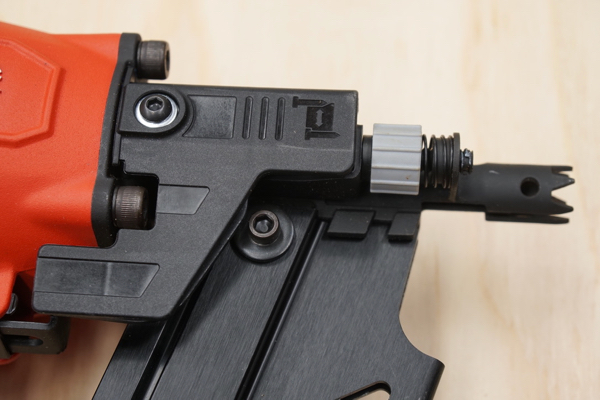
No-Mar Tip
Our crew members do not use a no-mar tip on a framing nailer – ever! If you were building a deck or dock using PT decking or maybe installing that horrible T-111 siding, maybe you would want to protect the wood surface. That said, the nailers with no-mar tips stored them in such a way as to guarantee they will get lost. As a result we decided not to score this category.
Weight And Size
WINNER – Metabo HPT
The length, width, and height of the nailers were used to determine their cubic volume, and the rank was assigned based on volume and tool weight. In the accompanying graph, the right column is the size ranking of the nailer, and the left column is the weight ranking.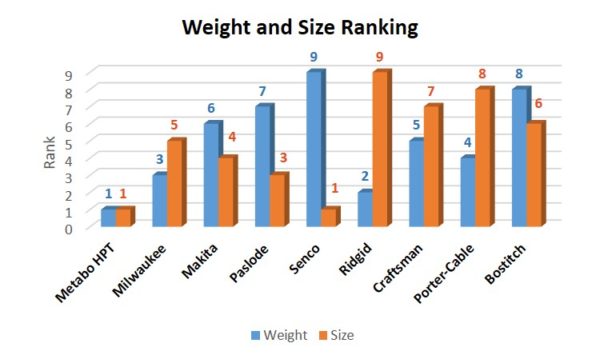
The Metabo HPT was the smallest and lightest nailer we tested and its size was a favorite among the team. Coming in second was Milwaukee followed by Makita.
Nail Magazine Capacity
WINNER – Metabo HPT
For a full-size framer, most folks will agree that you want the nailer to have a two-strip nail capacity. All of these nailers hold two strips. Some had a slightly higher capacity.
Noise/Decibels
We measured the decibel levels during the LVL header testing and recorded the results at a consistent, waist-high distance. Decibels were recorded at peak levels. As you can see below, these nailers are very close so we did not rank them. It’s important to note that all of these nailer require hearing protection.
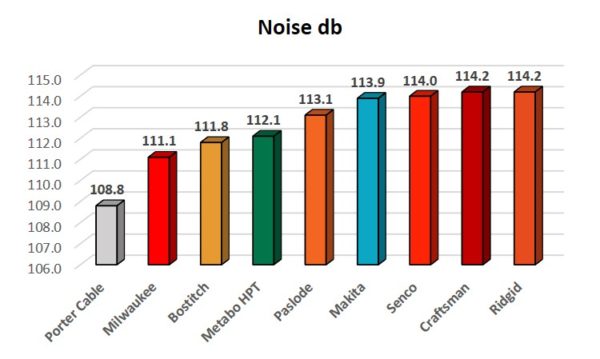
Noise is a severe hazard in construction. So any tool that offers lower sound signatures is essential to know. OSHA requires a hearing conservation program in place if workers are exposed to a time-weighted average (TWA) noise level of 85 decibels (dBA) or higher over an 8-hour work shift.
Ergonomics
WINNER – Makita and Milwaukee
The nailers are essentially the same from an ergonomic standpoint, but three nailers stood out as top contenders; Makita, Milwaukee, and Metabo HPT. We looked at how the tool interfaced with the user concerning the following five categories:
- Grip
- Rafter Hook
- Ease of Firing Mode
- Ease of Depth Adjustments
- Balance
Each tool was ranked on each category above. The team used a 1 thru 5 score, 1 being the best, to determine the tool with the best ergonomic ranking.
| Grip | Rafter Hook | Trigger Selection | Balance | Depth Adjustment | Setting Adjustments | Totals | |
|---|---|---|---|---|---|---|---|
| Makita | 2 | 2 | 1 | 2 | 1 | 1 | 9 |
| Milwaukee | 1 | 2 | 1 | 2 | 2 | 1 | 9 |
| Metabo HPT | 2 | 5 | 1 | 1 | 4 | 3 | 16 |
| Paslode | 1 | 1 | 5 | 1 | 5 | 5 | 18 |
| Bostitch | 3 | 3 | 5 | 3 | 4 | 2 | 20 |
| Ridgid | 4 | 4 | 3 | 4 | 2 | 3 | 20 |
| Senco | 4 | 2 | 5 | 3 | 3 | 4 | 21 |
| Craftsman | 5 | 4 | 4 | 5 | 3 | 3 | 24 |
| Porter Cable | 5 | 4 | 4 | 5 | 3 | 3 | 24 |
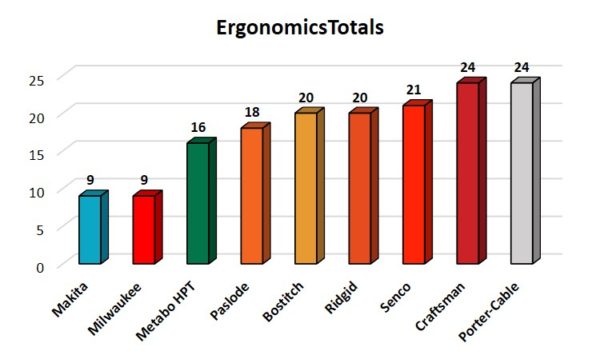
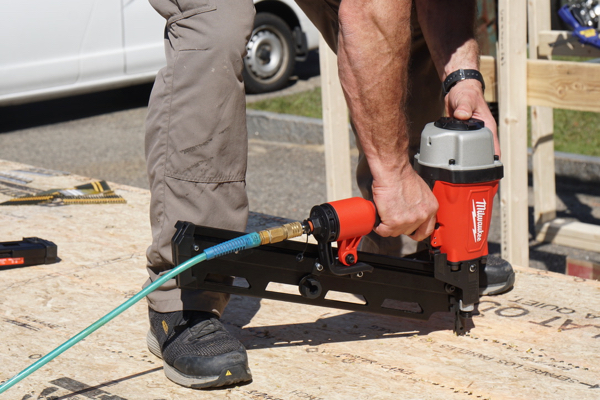
All three nailers had superior nailing mode selector switches. The Makita and Milwaukee had easier to use depth adjustments. The Metabo HPT has a clear line of sight, but the awkward placement of the depth adjustment is the trade-off. The location of the depth of drive does results in this nailer having the BEST sightline in our test.
The Metabo HPT has a beautiful line of sight ~ STAN
The Makita and Milwaukee tied for first place in ergonomics and were well ahead of the pack. They came in seven points ahead of the Metabo HPT, nine points ahead of Paslode, and 10-plus points ahead of the rest.
Toe-Nailing Evaluation
WINNER – Senco
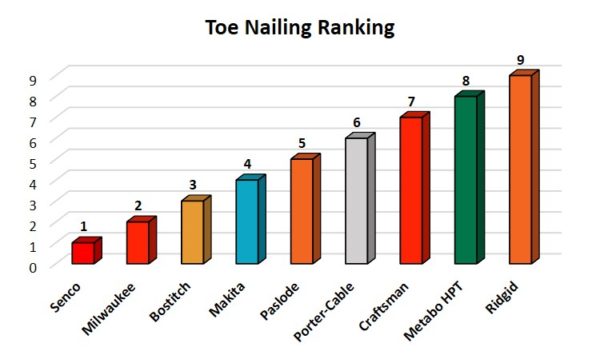
When toe-nailing, a nailer is held at approximately 60 degrees. Many framing nailer contact-tips slip in these situations, and the nailers with the most aggressive contact tip will toe-nail better. For toe-nailing framing applications, we used 3-1/2” nails to fasten 2×4 KD framing stud at an angle.
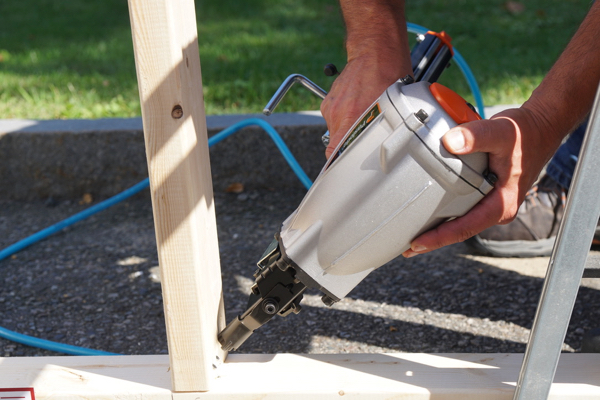
The Senco has the best tip. It has a “claw-like,” super aggressive tip that toe-nails well, with plenty of power. Milwaukee also has an aggressive tip, was powerful with solid and fully consistent toe-nailing. The Bostitch nailer has plenty of power, and it’s aggressive one-piece, cast-tip gripped well. The Makita nailer was “smooth!” It sank toenails consistently and is a powerful nailer. We’d like to see a more aggressive tip for toe-nailing.
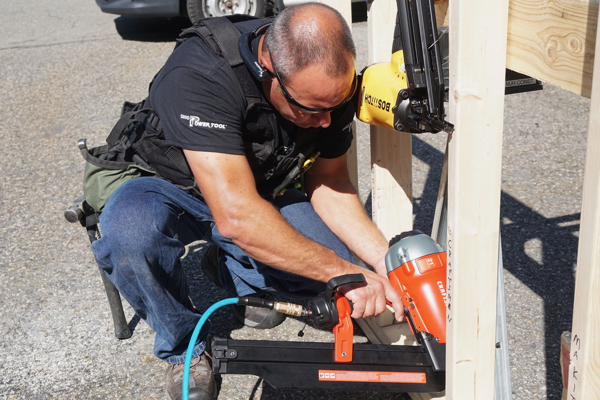
The Metabo HPT nailer is smaller than the rest and easily fits between studs. The contact-tip was aggressive and gipped the wood well. The team found that the Metabo HPT was slightly underpowered, with inconsistent toe-nailing penetration.
The RIDGID nailer did not perform well in our toe-nailing test. Power wasn’t the issue, and this nailer did well in our other tests. However, the RIDGID nailer was not able to sink toe-nails even at a maximum-depth setting and with the nose of the gun firmly buried in the wood.
Heavy-Duty Framing LVL Application – Power Test
WINNER – Senco
For this application, we used 3-1/2” framing nails to fasten LVL headers together. We placed two 1-3/4″ thick LVLs together, with a 2×8 underneath and face nailed. Each nailer installed a series of 10 fasteners, to compile an average measurement for nail penetration. We used the same compressor on all nailers and cycled the compressor to achieve maximum tank air pressure, prior to starting each and every test.
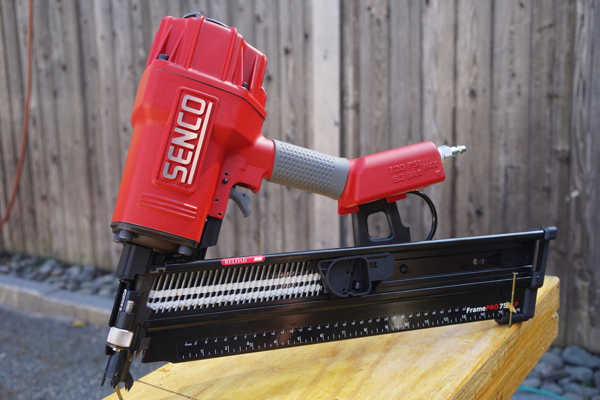
During the evaluation of Power (depth of drive) the nailers were evaluated in two different ways:
- Test 1: Testers set the nailers to approximately the “mid depth of drive” setting to get a sense of the average depth of drive.
- Test 2: This test was used to rank the nailers. Each nailer was set to it’s maximum depth of drive and the average depth of drive was measured for each.
The tests were run multiple times, and the results were compiled and an average determined. The chart below gives the average depth of drive in inches, with the nailers set to their maximum depth of drive.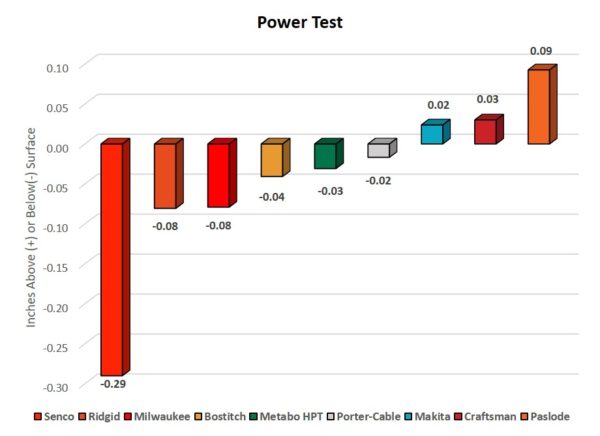
The SENCO had the best power and was able to consistently “over-drive” fasteners on every nail.
The SENCO walked away with the power test! ~ Stan Durlacher [TBBCrew]
The RIDGID in terms of power performed extremely well coming in second. Following closely in third place was the Milwaukee which had very low kickback and impressed the team.
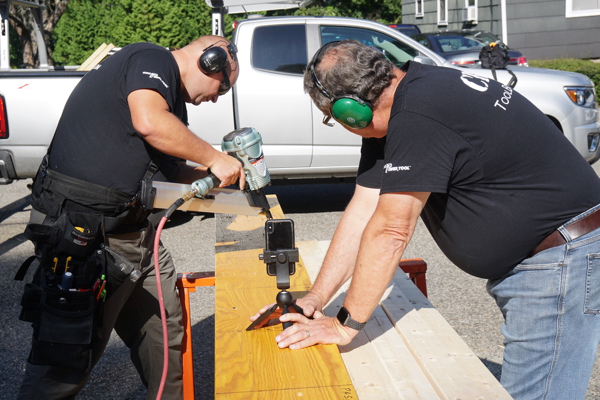
The advantages of pneumatic nailers are clear regarding power, productivity and capacity. The disadvantages commonly expressed among tradesmen are weight, compressor, hose, and maintenance. ~ Stan Durlacher [TBBCrew]
Medium Duty Framing Application – AdvanTech 3/4″ Sheathing Over LVL Studs
For this subjective application, we used 2-1/2” long framing nails to fasten 3/4″ AdvanTech sheathing to engineered studs (LVL). We did find that all the nailers were able to perform this task and achieve full penetration with very few nails that were not fully seated.
The Makita, Metabo, Senco and Paslode performed slightly better than the rest of the pack, but not enough to create a score ranking.
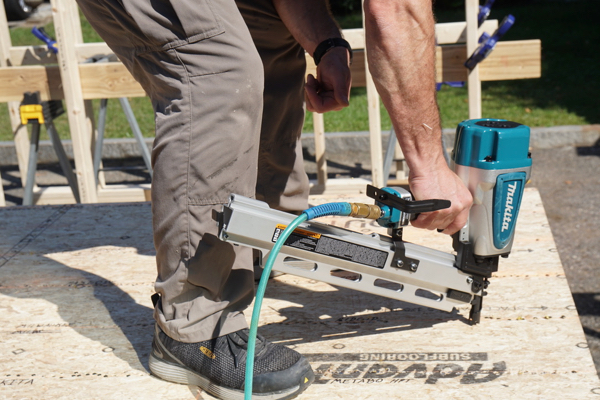
Framing contractors switch to a coil nailer for most sheathing applications like sub-floors, walls, and roofing. However, many carpenters own and operate ONLY one framing nailer. For those contractors, having the ability to adjust fastener depth when transitioning from framing walls to sheathing is important. In this situation, depth adjustment hurts the older style tools that require an Allen wrench depth adjustment over using a tool-less adjustment.
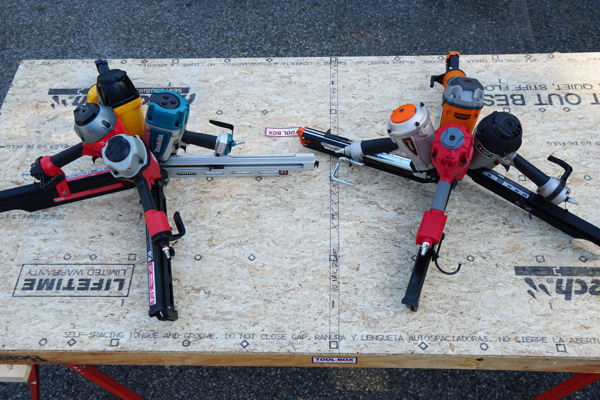
“I just want to keep on firing nails with this (Senco) gun!” -Ethan Bickford [TBBCrew]during the sub-floor test
Overhead Fastening Application
WINNER – Metabo HPT
For the overhead application, our intent was to assess performance and ergonomics in an overhead application. 3/4″ Pine strapping was fastened to LVL studs with 2-1/2” ring shank nails. No performance issues with fastening were noted.
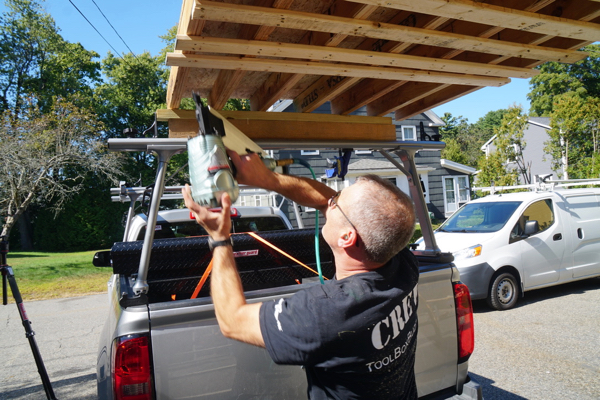
The Metabo HPT due to its lightweight design, was easier to position and maneuver and will obviously cause less shoulder and neck fatigue. All the other nailers were heavy for this task. The nailing pattern of two ring shank nails per joist/strapping connection makes for quick work with the advantages of a bump fire mode. However, one issue that does stand out for this task is the added weight of the other nailers, especially the Bostitch and Senco. The extra weight of these nailers can be a significant factor for user fatigue when using the tool for extended periods of time like nailing ceiling strapping.
Pricing
WINNER – Metabo HPT
Pricing fluctuates constantly so keep in mind the pricing listed here was at the time of this publication and may be different. Pricing listed is from independent retailers that we trust for great service so keep that in mind, some lower prices may be out there from less reputable retailers. There was a tie on pricing for this test but the nailers were different enough that we were able to rank one above all others based on the quality of the tool and outstanding value!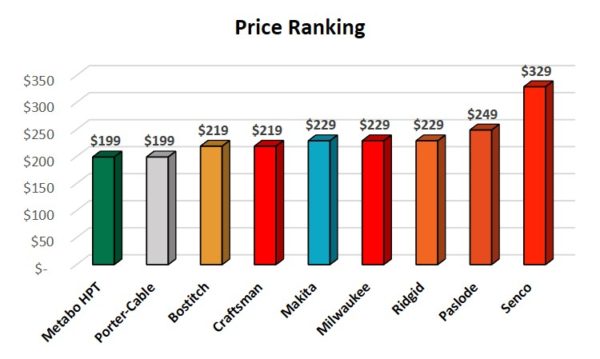
Metabo HPT and Porter Cable tied at $199.00. The team felt that the BEST nailer of the two, in almost all other tests, was the Metabo HPT and awarded it first place in this category. Coming in at third place was the Bostitch and Craftsman both listed at $219.00.
It’s important to understand that price is only one criterion in choosing the best nailer, with over-all performance topping that list.
Buy Now From Our Sponsored Retailers
Other Options
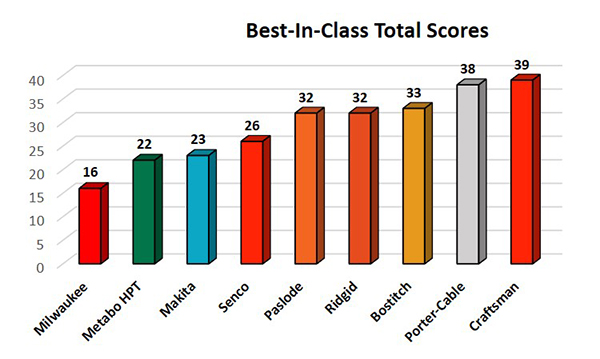
Best Full-Size Framing Nailer
WINNER – Milwaukee
Each tool was ranked in each category above. All of the categories ranked were then totaled to determine the total score to determine the Best Full-Size Framing Nailer.
The Milwaukee nailer is not new, and its stellar performance surprised the team. When it comes to pneumatic full-size framing nailers, the Milwaukee 7200-20 surely ranks at the top of the list when power, performance, ergonomics, and features are concerned. It came in at a total of 16 points, which was 6-points ahead of the second-placed Metabo HPT, and 7-points ahead of the third-place Makita. [See Chart Below]
| Power | Nail Cap. | Toe Nail | Size | Ergo | Features | Price | Total | Rank | |
|---|---|---|---|---|---|---|---|---|---|
| Milwaukee | 2 | 4 | 2 | 2 | 1 | 1 | 4 | 16 | 1 |
| Metabo HPT | 4 | 1 | 8 | 1 | 3 | 4 | 1 | 22 | 2 |
| Makita | 6 | 3 | 4 | 3 | 1 | 2 | 4 | 23 | 3 |
| Senco | 1 | 6 | 1 | 4 | 5 | 3 | 6 | 26 | 4 |
| Paslode | 8 | 2 | 5 | 4 | 3 | 5 | 5 | 32 | 5 |
| Bostitch | 3 | 7 | 3 | 7 | 4 | 6 | 3 | 33 | 6 |
| Porter-Cable | 5 | 7 | 6 | 6 | 6 | 6 | 2 | 38 | 7 |
| Ridgid | 2 | 5 | 9 | 5 | 4 | 3 | 4 | 32 | 5 |
| Craftsman | 7 | 7 | 7 | 6 | 6 | 6 | 3 | 39 | 8 |
Final Thoughts – Best Full-Size Framing Nailer
We get lots of comments about how we make the final rankings. As we’ve stated, there are hundreds of ways to compare tools. The good news is we’ve openly shared ALL the data from our tests, and you can rank the tools however you want. Don’t care about the price? No problem eliminate that from the matrix above and re-rank them. Hopefully, you’ll find this Head-To-Head useful in comparing a wide range of full-size pneumatic framing nailers.
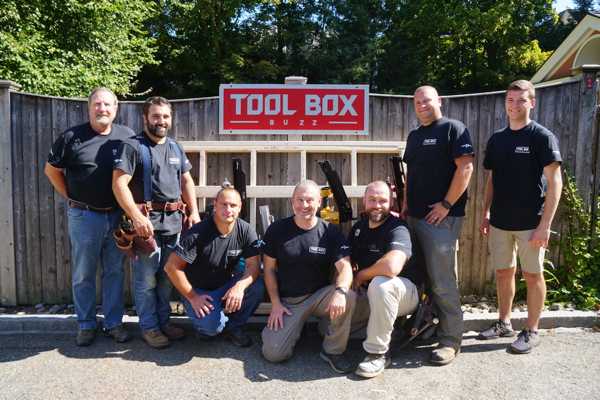
Did You Know …..
Interesting Fact On Nailer “Kickback”
Kickback is a product of a few factors, tool weight, the density of the material being nailed, size of the fastener, and the speed with which force is applied to the fastener. Kickback was a difficult problem to overcome in the early days of pneumatic nailers. In short, manufacturers needed to be able to overcome kickback, resulting in a few solutions developed around the same time but in the end, a “pop-it” valve developed for ejection seats on fighter planes was adapted for use in nail guns and that is essentially the same technology used in pneumatic nailers today.
Source: Tools of The Trade –A Brief History of Portable Nail Guns by Don Carlson
Best Framing Nailer Video Review
About the author
10 Comments
Leave a comment
Disclosure
Product reviews on this site contain our opinion of a product or service. We will always strive for objectivity and transparency in our reviews. Our goal is to provide readers with honest, objective information based on our own experiences. We never have and never will accept payment in exchange for a positive review. Many of the products that we review are provided to us for free by a manufacturer or retailer. In some cases, we also have advertising or affiliate relationships with manufacturers and retailers of products and services we review. For additional information please visit our additional disclosure policies.











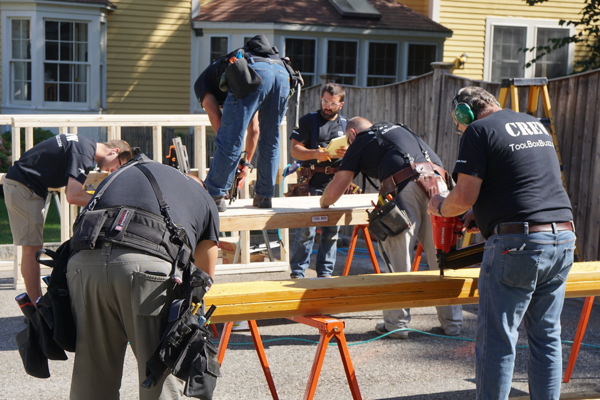
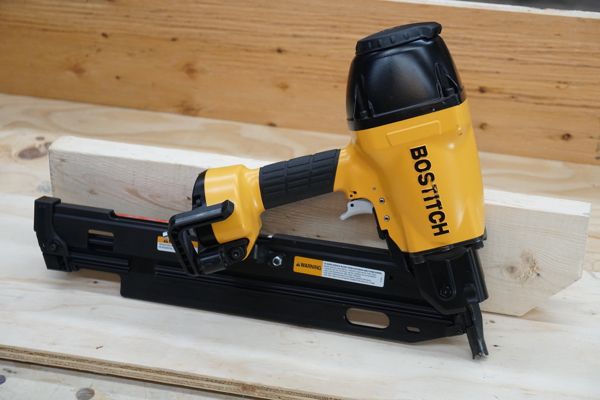
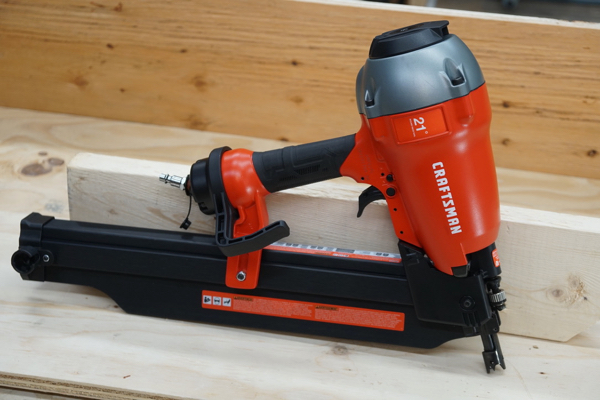
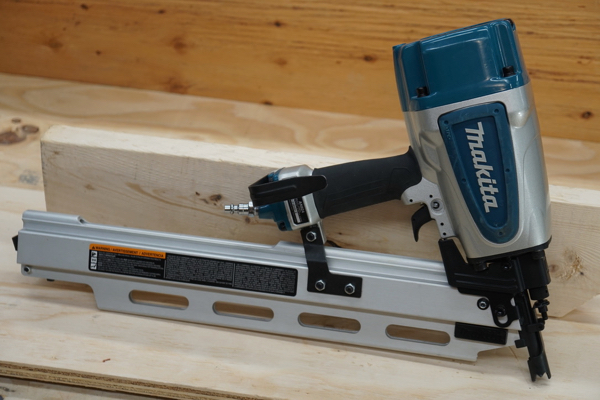
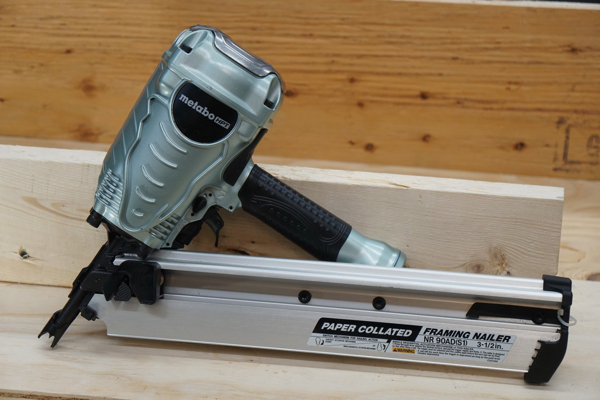
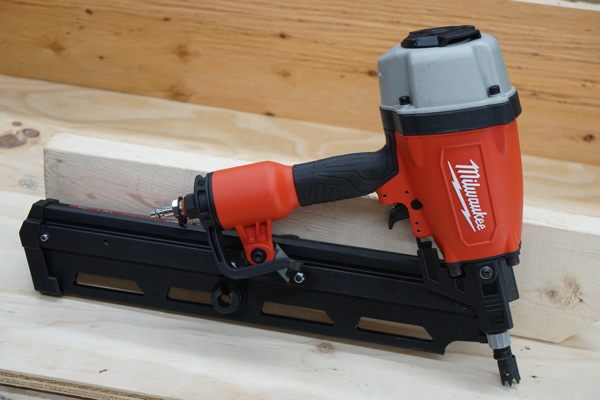
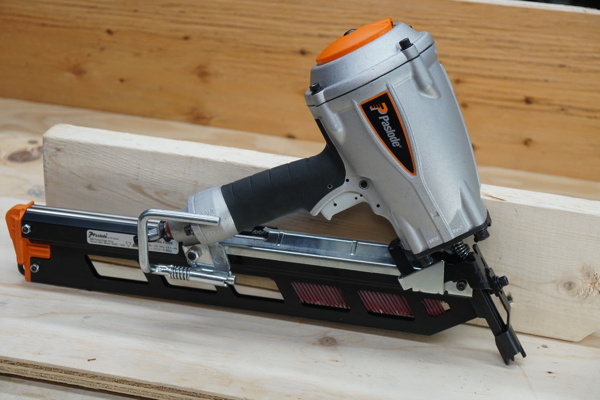
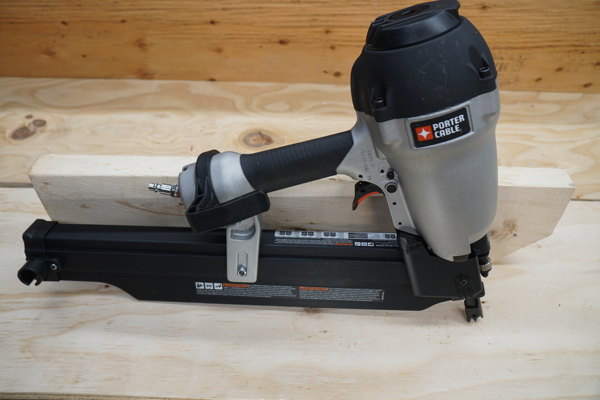
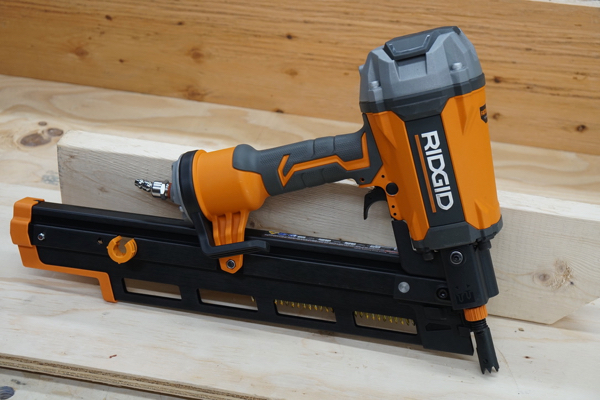
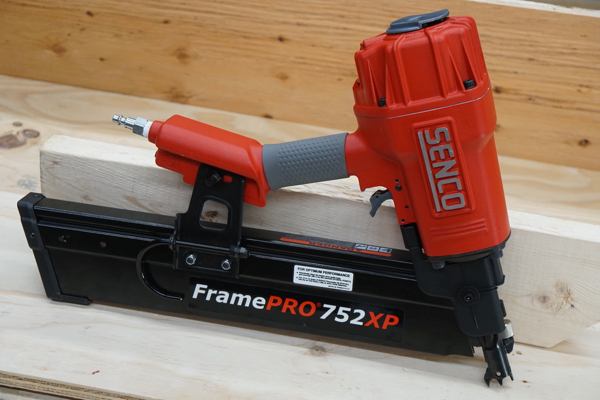
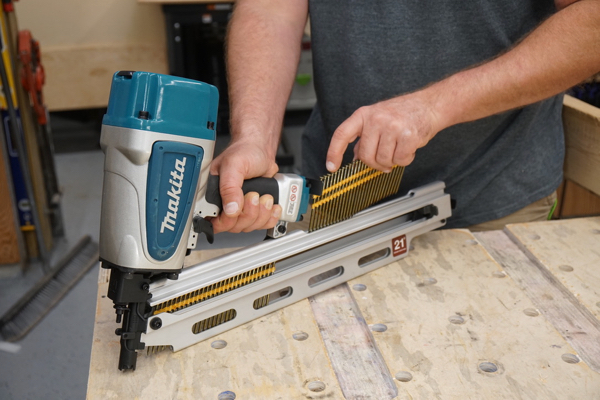
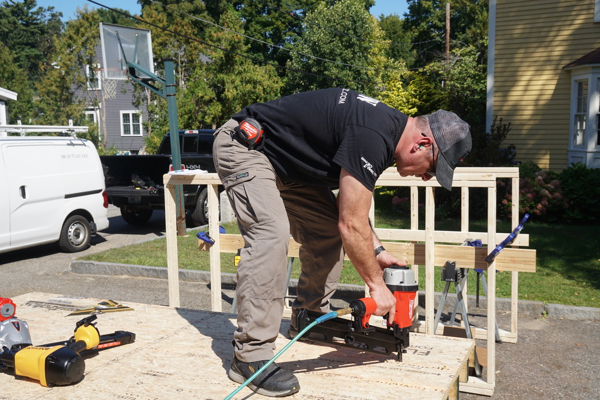
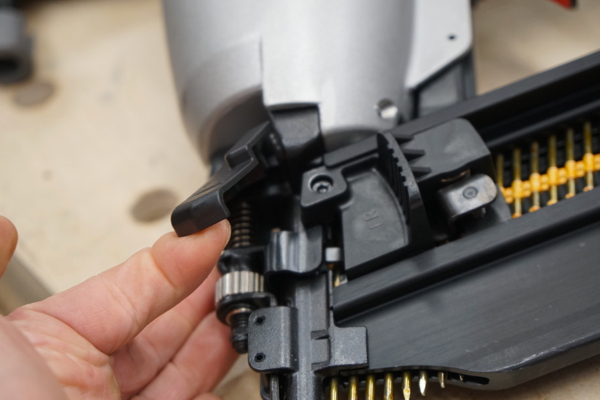
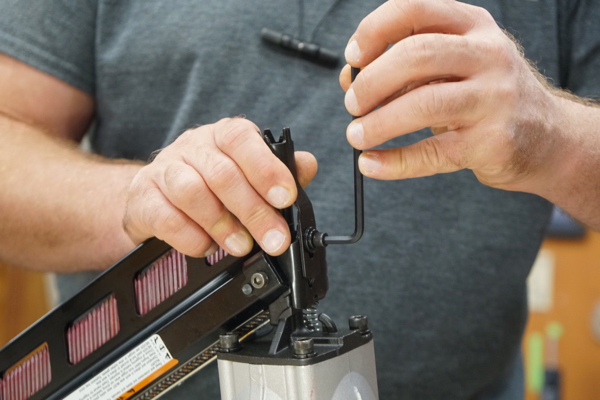
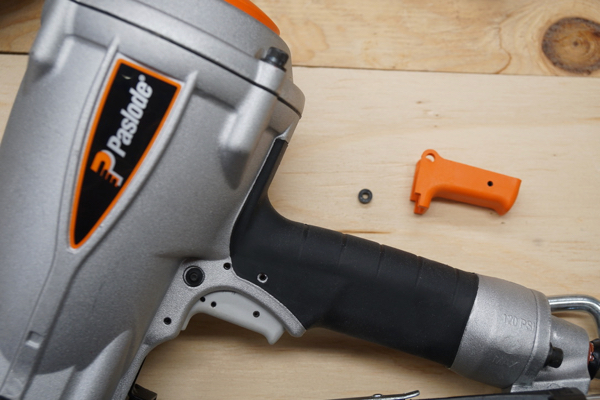
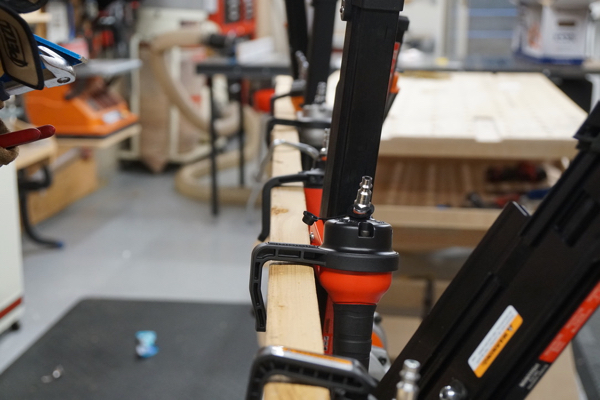
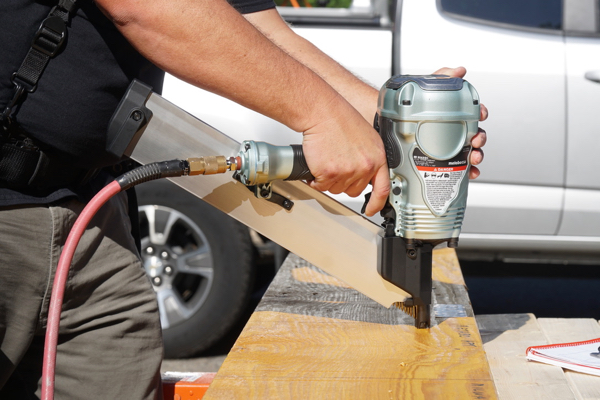
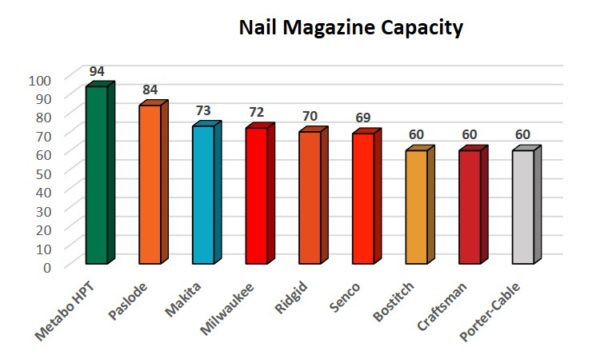
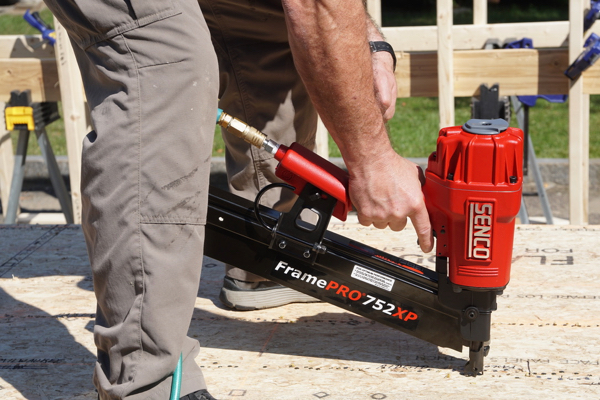
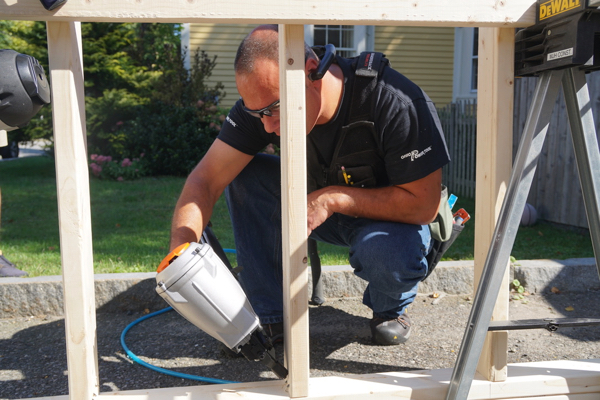

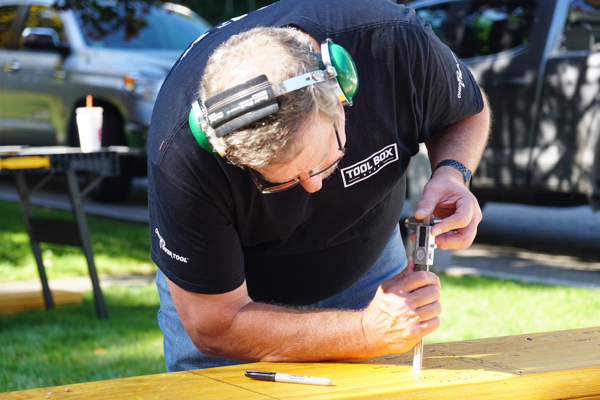
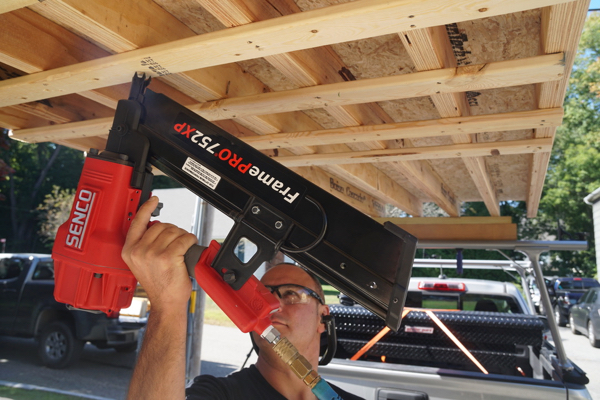












[…] this SENCO FramePro 752XP 3 1/2″ Framing Nailer up against 8 of it’s top competitors in our Best Framing Nailer Head-to- Head. While the SENCO did not come out on top it was very competitive in all categories. Let’s […]
You do no list nail diameter only length. A 3-1/2″ x .131″ nail is not a nail per the building codes.
Hi George,
Length and diameter correspond with common nail sizes and type. both in loose nails and in gun nails. A 3-1/2″ nail is .135″ for a box or gun nail and .162″ for a common nail. Both are listed in the nailing schedules in the IRC (International Residential Code) Table 602.3
Buy the paslode it will last far longer than the metabo . As far as I am concerned metabo is for DIY’s.
Michael – The paslode is a nice nailer, however, your assessment of the Metabo HPT isn’t a fair one. Essentially this is a Hitachi nailer and a damn fine one. They have great history in nailers and that wasn’t lost with the name change.
Excellent article–thorough, clearly written and very useful! Thanks
Is there any significant difference between the 21-degree and 30-degree nailers aside from capacity and weight? You’ve listed the model number for the 30-degree Metabo nailer (NR90AD(S1)) but you have it labelled as the 21-degree model (should be NR90AES1), so I’m curious if that would have any effect on the rankings.
The angle of fasteners really doesn’t effect much. It’s really about local availability and personal preference.
Why not test Dewalt DWF83Pl 21 degree also? On sale are Home Depot November 2021. Would like opinion
Bill – That article was written a couple years ago, the models tested were the most recent ones available at the time.